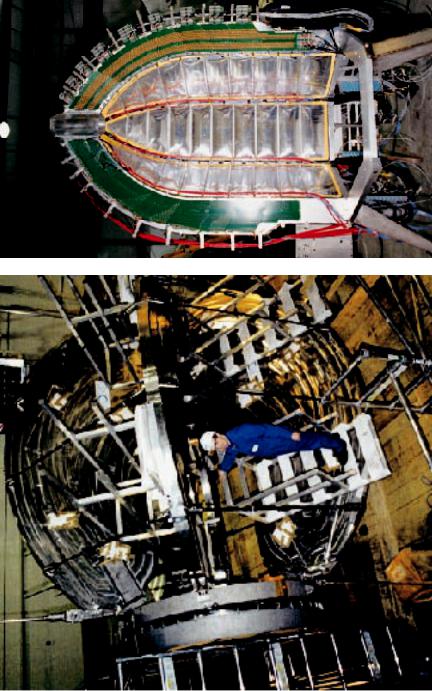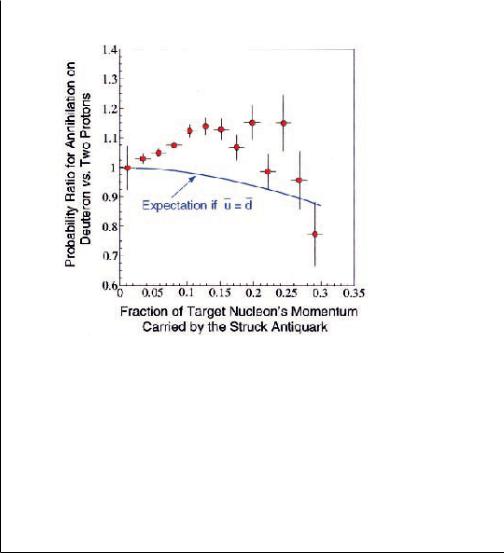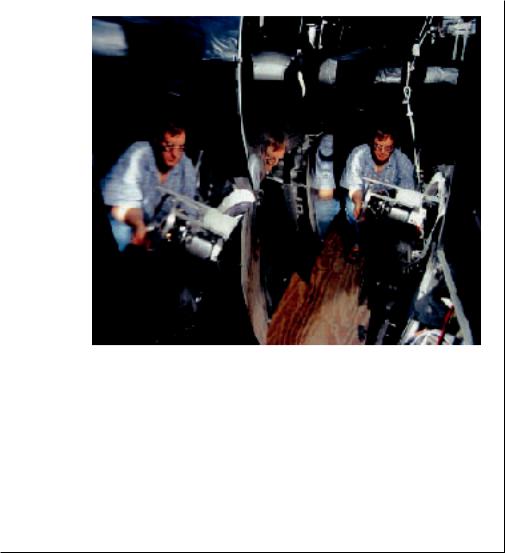
6288
.pdfNuclear Physics: The Core of Matter, The Fuel of Stars
http://www.nap.edu/catalog/6288.html
24 |
NUCLEAR PHYSICS: THE CORE OF MATTER, THE FUEL OF STARS |
Spin polarization refers to the preferential orientation, along some chosen direction in space, of the intrinsic spins of the particles that make up a beam or a target. With techniques now available, the spins can be aligned in the same direction for as many as 90 percent of the electrons in a beam or the protons in a target. Furthermore, polarized neutrons can be prepared inside polarized deuterium or 3He nuclei, for use as targets, as indicated in Figure 2.3. The polarization is a powerful tool; it allows one to separate the effects of small but important processes that depend strongly on the polarization direction of the beam and/or target from more dominant contributions to the scattering that depend differently, or not at all, on the polarizations. For example, polarization measurements allow, for the first time, high-precision maps of the small but nonzero electric-charge distribution within the uncharged neutron, without being overwhelmed by the effects of the much stronger interactions of the electron beam with the magnetism of the neutron or with the charge of the partner proton inside a deuterium target nucleus. The new technology also provides access to new structural features, such as the spin substructure of the nucleon: deep-inelastic-scattering experiments carried out with polarized beams and polarized targets have begun to reveal how the spins and orbital motions of quarks and gluons combine to produce the overall angular momentum of a proton or a neutron.
One of the inherent difficulties in obtaining new information on hadron structure is that high energies are required to probe small objects. At these high energies, many new particles can be produced in reactions with nucleons. New structure properties can be determined if these particles can be analyzed and identified as coming from the interaction of a single beam particle with a single target particle. Thus, detectors that can track many particles simultaneously, over broad ranges of angle and energy, are required. Suitable systems, such as that pictured in Figure 2.4, are being commissioned and shortly will allow a new class of electron-scattering experiments to be performed. It is also crucial to use accelerators that deliver the electron beam continuously to the target, rather than in short time bursts, in order to attain practical counting rates for the events of interest while minimizing the rate of “accidental” coincidences among particles arising from two or more unrelated interactions in the target. CEBAF—the most powerful continuous-beam electron accelerator ever built—provides a microscope of unprecedented capabilities for studies of nucleon structure.
Electromagnetic interactions, such as deep inelastic scattering, are sensitive to the charge and magnetism of quarks, but not to other quark properties, and not sensitive at all to the uncharged gluons that bind the quarks together. To obtain a more complete picture of the nucleon substructure, it is important to complement these sensitivities with measurements of quite different processes induced by beams of high-energy hadrons. One example, illustrated in Figure 2.2, is known as Drell-Yan annihilation, where a quark from a hadron projectile undergoes matter-antimatter annihilation with an antiquark from the target (or vice versa). Studies of this process have allowed separation of structure features
Copyright © National Academy of Sciences. All rights reserved.

Nuclear Physics: The Core of Matter, The Fuel of Stars
http://www.nap.edu/catalog/6288.html
THE STRUCTURE OF THE NUCLEAR BUILDING BLOCKS |
25 |
FIGURE 2.3 Among recent technological advances that facilitate dramatic improvements in measurements of neutron substructure is the development of spin-polarized 3He targets of usable density. The photograph shows a cell filled with 3He gas, which is exposed to laser light of appropriate frequency to “pump” most of the gas atoms into a state with the desired orientation of the nuclear spin. The purple glow is from light emitted by excited 3He atoms. This particular target has been used in a deep inelastic scattering experiment to measure the contributions of quarks and antiquarks to the overall spin of a neutron.
The lower frame illustrates why a spin-polarized 3He nucleus can serve as an effective surrogate for a target neutron of known spin orientation. The nucleus comprises two protons, which spend nearly all of their time with opposite spin orientations, plus a single neutron, which nearly always shares the spin preference with which the 3He nucleus is prepared. To good approximation, it is only the quarks and antiquarks inside the neutron that contribute to changes in the scattering probability when the 3He spin is reversed.
Copyright © National Academy of Sciences. All rights reserved.

Nuclear Physics: The Core of Matter, The Fuel of Stars
http://www.nap.edu/catalog/6288.html
26 |
NUCLEAR PHYSICS: THE CORE OF MATTER, THE FUEL OF STARS |
Copyright © National Academy of Sciences. All rights reserved.
Nuclear Physics: The Core of Matter, The Fuel of Stars
http://www.nap.edu/catalog/6288.html
THE STRUCTURE OF THE NUCLEAR BUILDING BLOCKS |
27 |
FIGURE2.4 PartsoftheCEBAFLargeAcceptanceSpectrometer. Thissystemallowsonetodetect,identify,andmeasurethemomentaof multipleparticlesresultingfromtheinteractionofenergeticelectronbeamswithnucleonsandnuclei. Atitscoreisanovelsuperconducting magnetthatproducesatoroidalfieldcapableofbendingthetrajectoriesoftheemergingparticleswithoutperturbingaspin-polarizedtarget mountedalongthespectrometer’saxis. Three(outofatotalofsix)“slices”ofthesuperconductingcoilsforthismagnetareshowninthe photographontheleft. Detectorsfitinbetweenandbeyondthecoils,includingtheinner“driftchambers”shownontheright,whichmeasure preciselythepositionwherechargedparticletrackscrossthem. Whencoupledwiththecontinuousbeamavailablefromtheaccelerator,this spectrometerwillfacilitateexperimentsofunprecedentedthoroughnesstoprobethestructureofnucleonsandtheirmanyexcitedstates. (CourtesyoftheThomasJeffersonNationalAcceleratorFacility.) |
|
Copyright © National Academy of Sciences. All rights reserved.
Nuclear Physics: The Core of Matter, The Fuel of Stars
http://www.nap.edu/catalog/6288.html
28 |
NUCLEAR PHYSICS: THE CORE OF MATTER, THE FUEL OF STARS |
associated with the primary (valence) quarks versus the induced “sea” of quarkantiquark pairs. Other processes can produce gluon maps of very fast colliding nucleons, by measuring the probability to create new particles, or high-energy gamma rays, in whose formation the gluons in one or both participants play the decisive role. Experiments using such hadron probes will benefit greatly from recent technological advances. For example, at RHIC the contributions of gluons and sea quarks to the proton’s spin will be discerned from the results when two very high-energy beams of spin-polarized protons collide.
Experimental Opportunities
According to the Standard Model of particle physics, quarks and antiquarks come in six different varieties, or “flavors,” characterized by different masses. Only the two lightest varieties, called up quarks and down quarks, participate as valence quarks in nucleons. Indeed, in the original, simplified picture of a proton’s substructure, all its properties were thought to arise from combining two up quarks and one down quark in a state with no relative orbital motion. Although this picture provides a deceptively successful account for some properties, such as the overall magnetism of the proton and neutron, it is clearly an incomplete representation of the complex quark-gluon dynamics. Experiments planned for the coming decade should yield a far more realistic picture of what goes on inside the nucleon, including the roles of sea quarks of various flavors, of gluons, and of the orbital motion of all these constituents.
The induced sea of quarks and antiquarks inside a nucleon is a fascinating manifestation of the strong confining forces that nuclear physicists seek to understand. Electrically charged particles, which interact via the much weaker electromagnetic force, have a small probability to liberate virtual electron-positron pairs from the surrounding vacuum. These particles are called virtual because they exist only fleetingly, soon to be swallowed up by the vacuum once again. These electron-positron pairs have subtle, but measurable, effects on the structure of atoms—effects whose study led to crucial early successes of the field theory known as quantum electrodynamics. In contrast, the analogous pairs of virtual quarks and antiquarks in a nucleon are excited with high probability and profoundly influence the nucleon’s properties. It is a critical goal of experiments on nucleon structure to probe the relative probabilities for finding quarks of different flavors in the sea.
For example (see Box 2.1 for details), recent measurements of both deep inelastic scattering and Drell-Yan annihilation processes have refuted the naive expectation that anti-up and anti-down quarks might be found with equal probability in the proton’s sea. A most intriguing implication of this discovery is that the essence of the sea may be captured in a picture where the virtual quarkantiquark pairs are thought of as mesons, which they resemble (as can be seen in Figure 2.1). In particular, the observed preference for anti-down quarks is consis-
Copyright © National Academy of Sciences. All rights reserved.

Nuclear Physics: The Core of Matter, The Fuel of Stars
http://www.nap.edu/catalog/6288.html
THE STRUCTURE OF THE NUCLEAR BUILDING BLOCKS |
29 |
BOX 2.1 Sampling the Proton’s Flavors
How, exactly, are protons and neutrons made? Nature has guarded her secret recipes as vigilantly as the Coca-Cola Company, even to the extent of forbidding the ingredients from ever being used alone. Nonetheless, nuclear physicists are uncovering the proton’s secrets little by little, exploiting ever more selective techniques to isolate individual “flavors” in the complex mélange.
Physicists have discovered six flavors, or varieties, of quarks—the tiny constituents of protons, neutrons, and all their heavier cousins. The different flavors have been given the metaphorically confused names: up, down, strange, charmed, bottom, and top. Until recently, only the two lightest types, up and down, were known with certainty to reside in a proton. Indeed, many of the proton’s distinguishing features can be understood as emerging from a combination of three primary—two up and one down—quarks. Surprisingly, though, physicists believe that these primary (or valence) quarks account for only a small fraction of the proton’s mass. Some of the remaining mass is associated with a “sea” of quarkantiquark pairs induced by the presence of the valence quarks. Though individual pairs appear and vanish, they are found with high probability, much as the flickering lights in a dense swarm of fireflies. The transient quarks and antiquarks in this sea can be of the up or down variety or, in principle, of any other flavor. The flavor composition of the quark sea, which gives the proton and the neutron much of their complexity and richness, is the focus of a number of ongoing experiments.
Physicists’ initial naive expectation was that nature would mix different flavors in the sea in proportions depending only on the quark mass associated with each flavor. Since up and down quarks have nearly equal masses, they should then appear with nearly equal probability in both protons and neutrons. That expectation is refuted by recent results, shown in Figure 2.1.1, from an experiment at the
Fermi National Accelerator Laboratory. These results imply a strong preference for down over up antiquarks in the proton’s sea.
Why should nature prefer such a flavor imbalance? One possible explanation is that the proton spends some of its time as a neutron surrounded by a positively charged pi meson. But this description uses the language of conventional nuclear theory, dealing with protons, neutrons and mesons, rather than with quarks directly. One of the primary goals of nuclear physics is to understand the relations between these two languages, and the conditions under which one or the other provides the more efficient description of matter. The result of the Fermilab experiment suggests that the theoretical framework that works best for treating the structure of nuclei may also be unexpectedly useful in treating the internal structure of protons and neutrons.
Quark flavors other than up or down can appear in a proton only as part of the sea. At present, there is particular interest in the strangeness flavor, which corresponds to the next lightest quark mass after up and down quarks. Hints from several different experiments have suggested that strange quarks and antiquarks have a greater role in the proton than would be expected on the basis of their mass alone. A series of ongoing and planned experiments at several laboratories (an example is shown in Figure 2.1.2) seeks to distinguish strange quarks by their contribution to the weak interaction between electrons and protons. This interaction will be unmasked from the normally dominant electromagnetic interaction by searching for a characteristic violation of mirror symmetry. The violation can be
Copyright © National Academy of Sciences. All rights reserved.

Nuclear Physics: The Core of Matter, The Fuel of Stars
http://www.nap.edu/catalog/6288.html
30 |
NUCLEAR PHYSICS: THE CORE OF MATTER, THE FUEL OF STARS |
BOX 2.1 Continued
FIGURE 2.1.1 Recent results from an experiment carried out at Fermilab refute the simple expectation (blue curve) that the induced sea of quark-antiquark pairs in a proton or neutron contains up and down quark flavors in equal amounts. An experimental team led by nuclear physicists from Los Alamos National Laboratory has found the down flavor strongly prevalent in the proton’s sea. They studied processes where a valence quark in a high-energy beam proton preferentially annihilates a sea antiquark in either a proton or deuteron target. A deuteron contains one neutron and one proton.
determined in precise measurements of a tiny expected difference in the scattering rates when the electron beam is prepared in two different ways: with most of the electrons spinning clockwise versus counterclockwise, as seen from the electron’s direction of motion.
Many more questions remain to be addressed to discern nature’s complete recipes for protons and neutrons. They concern, for example, the presence of
tent with the effect of the proton occasionally emitting, then reabsorbing, a virtual pi meson. The conventional view of nuclei, in terms of nucleons and mesons rather than quarks and gluons, may thus even provide a relevant approximation to QCD in treatments of nucleon structure. It will be interesting to see if such treatments also remain useful in addressing the presence of heavier quarks and antiquarks, such as those with the “strangeness” flavor, in the nucleon’s sea. As discussed in Box 2.1, a series of experiments at CEBAF and other accelerators is
Copyright © National Academy of Sciences. All rights reserved.

Nuclear Physics: The Core of Matter, The Fuel of Stars
http://www.nap.edu/catalog/6288.html
THE STRUCTURE OF THE NUCLEAR BUILDING BLOCKS |
31 |
FIGURE 2.1.2 A part of the detector constructed at the University of Illinois, which is currently in use at the Bates accelerator to study small violations of mirror symmetry in electron-proton scattering. One of the collaborators is seen among the large reflectors used to focus radiation emitted by the scattered electrons. The experiment, initiated at the California Institute of Technology, is sensitive to the presence of the strangeness flavor in the quark-antiquark sea within a proton. (Courtesy of the MIT Bates Linear Accelerator Center.)
even heavier quark flavors, the contributions of different flavors to the overall spin of a proton, and possible changes in the flavor makeup between protons and neutrons, or between free protons and those embedded in nuclei. The ultimate goal is to understand how nature’s choice of recipes has determined the character of the world around us.
aimed at determining the contributions of strange sea quarks to nucleon properties.
A particular nucleon property in which strange quarks may play a significant role is the spin substructure. The intrinsic spin and the associated magnetism of a proton are among its defining characteristics. They are, for example, essential in accounting for radiation observed from the heavens and in allowing magnetic resonance imaging. Measuring and understanding the relative contributions to
Copyright © National Academy of Sciences. All rights reserved.
Nuclear Physics: The Core of Matter, The Fuel of Stars
http://www.nap.edu/catalog/6288.html
32 |
NUCLEAR PHYSICS: THE CORE OF MATTER, THE FUEL OF STARS |
the proton’s spin from its various constituents is a major goal of nuclear physicists. The first information has been provided by recent, polarized, deep-inelas- tic-scattering experiments. The results, shown in Figure 2.5, suggest that the intrinsic spins of all the quarks and antiquarks combined account for only a fraction (less than about 30 percent) of the nucleon’s overall spin. In particular, the net contribution from up and down quarks seems to be partially canceled by that from the strange quarks, which appear to line up opposite to the overall spin direction. However, this interpretation relies on arguments based on quite different measured properties of hadrons, and it must be confirmed by future experiments that can separate the spin contributions from valence and sea quarks, and from quarks of different flavors.
The next generation of experiments on the spin substructure will study reactions induced by both polarized lepton (electron, positron, and muon) beams and polarized proton beams on polarized protons. The results will also provide the first information on the contribution from the spin of gluons to the proton spin, a contribution that recent theoretical work suggests may be large. Experiments with colliding beams of polarized protons at RHIC will be especially well suited to probe this gluonic role. If the quark and gluon spins together do not account for the nucleon spin, the only remaining source available to “balance the books” (as indicated in Figure 2.5) is the relative orbital motion of the quarks and gluons. Thus, early in the next century, these experiments on the spin substructure may indirectly lead us beyond our current, still rudimentary understanding of quark motion inside a nucleon.
One of the major advances of the past five years was the first measurement of the spin substructure of a polarized neutron, made possible by innovative developments in spin-polarized deuterium and 3He targets. These experiments permitted a quantitative test of a rigorous QCD prediction, the Bjorken sum rule, for the net difference between the quark spin distributions in a proton and a neutron. The recent data agree with the sum rule value, demonstrating that our maturing picture of the nucleon’s substructure remains consistent with QCD.
In parallel with these probes of the “trees” inside the nucleon “forest,” nuclear physics experiments are improving the quality of the global view of the forest itself, by applying modern technology to study the electromagnetic interactions of nucleons at lower energies. One example, illustrated in Figure 2.6, is the vastly improved precision expected from ongoing polarization experiments mapping the neutron’s electric charge distribution, which is related to the overall spatial layout of valence and sea quarks. A second example is provided by recent measurements of the distortions induced in a nucleon’s charge and magnetization distributions when it is exposed to external electric and magnetic fields. These properties have been measured by scattering beams of photons—the quantum carriers of the electric and magnetic fields—from nucleons. Greater flexibility in the nature of these stimulating fields can be obtained, and hence a number of new features of the nucleon’s response can be measured, in future experiments in
Copyright © National Academy of Sciences. All rights reserved.

Nuclear Physics: The Core of Matter, The Fuel of Stars
http://www.nap.edu/catalog/6288.html
THE STRUCTURE OF THE NUCLEAR BUILDING BLOCKS |
33 |
FIGURE 2.5 How do the proton’s various constituents contribute to its overall spin? As illustrated by the upper diagram, the quarks, antiquarks, and gluons are all believed to have their own intrinsic spins, and these must contribute. But so also must the relative orbital motions of the quarks and gluons inside the proton. Measuring and understanding the relative contributions from these different sources is a major goal of nuclear physicists.
The first measurements of the proton’s spin substructure have been made recently, employing the technique of deep inelastic scattering with spin-polarized beams bombarding spin-polarized targets. By combining these measurements with constraints from other data, one can infer the fraction of the proton’s spin carried by the intrinsic spin of quarks (and antiquarks) of different flavors. The results of experiments performed at CERN, SLAC, and DESY, summarized in the graph, point to an unexpected outcome: all the quarks and antiquarks together account for no more than one-third of the total spin. More direct probes of the spin alignment of different flavors of quarks, separation of the contributions from quarks and antiquarks, and extraction of information on the gluon spin contributions are goals of ongoing and planned second-generation experiments.
Copyright © National Academy of Sciences. All rights reserved.
